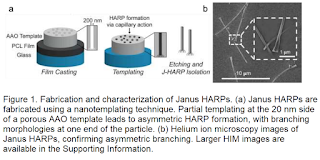In ancient Roman mythology, Janus is the god of doors and gates. He is depicted as having two faces because he is both looking outward and inward at the same time. Having a dual nature is a property which would be desirable for nanoparticles as this will enable the ability for more complicated functions. Recently, researchers at University of California San Francisco used PLGA-PEG-Biotin (AI167) and PLGA (AP061) to create long, tubular nanoparticles with different functionalities based on orientation. This research holds promise to allow more complicated nanotechnology operations by having higher control over the shape and geospatial considerations of nanoparticles. Read more: Finbloom, Joel A., Yiqi Cao, and Tejal A. Desai. "Bioinspired Polymeric High Aspect Ratio Particles with Asymmetric Janus Functionalities." Advanced NanoBiomed Research: 2000057. https://onlinelibrary.wiley.com/doi/abs/10.1002/anbr.202000057
“Abstract: Polymeric particles with intricate morphologies and properties have been developed based on bioinspired designs for applications in regenerative medicine, tissue engineering, and drug delivery. However, the fabrication of particles with asymmetric functionalities remains a challenge. Janus polymeric particles are an emerging class of material with asymmetric functionalities; however, they are predominantly spherical in morphology, made from non‐biocompatible materials, and made using specialized fabrication techniques. We therefore set out to fabricate nonspherical Janus particles inspired by high aspect ratio filamentous bacteriophage using polycaprolactone polymers and standard methods. Janus high aspect ratio particles (J‐HARPs) were fabricated with a nanotemplating technique to create branching morphologies selectively at one edge of the particle. J‐HARPs were fabricated with maleimide handles and modified with biomolecules such as proteins and biotin. Regioselective modification was observed at the tips of J‐HARPs, likely owing to the increased surface area of the branching regions. Biotinylated J‐HARPs demonstrated cancer cell biotin receptor targeting, as well as directional crosslinking with spherical particles via biotin‐streptavidin interactions. Lastly, maleimide J‐HARPs were functionalized during templating to contain amines exclusively at the branching regions and were dual‐labeled orthogonally, demonstrating spatially separated bioconjugation. Thus, J‐HARPs represent a new class of bioinspired Janus material with excellent regional control over biofunctionalization.”

No comments:
Post a Comment